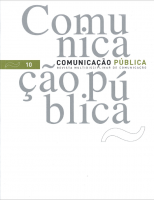Grassroots 2.0
Public Diplomacy in the Digital Age
DOI:
https://doi.org/10.4000/cp.422Palavras-chave:
grassroots, public diplomacy, two-way communication, web 2.0 , media, Mexico, TurkeyResumo
Rapid advancements in communication and transportation technologies in recent history have created new and emerging tools that make it possible for every individual to share information with a global audience. Social networking technologies, especially, have revolutionized the possibilities of person-to-person communication, particularly by making obsolete the geographical boundaries that once divided cultures and nationalities. Diplomacy, an international relations activity traditionally claimed as the domain of the nation-state, has become more accessible to ‘ordinary’ citizens and advocacy groups and is taking new forms as individuals and groups initiate grassroots public diplomacy activities. This paper presents the case studies of two such initiatives—Turkayfe.org and the Rediscover Rosarito Project—that have successfully implemented new communications technologies and Web 2.0 strategies in their international outreach campaigns.
Downloads
Referências
AFP (2009). Clinton Vows U.S. Backing in Mexican Drug Wars. Yahoo News, March 25. http://www.google.com/hostednews/afp/article/ALeqM5jyn1lZ9qaKDzJId1R__UD17LpT_w (Accessed April 29, 2009).
Baja Times (2008). Campus Movie Fest and Graduate Students and Faculty from Emerson College – Boston Present Rediscover Rosarito Student Documentary Film Workshop and Festival. July/August. http://www.bajatimes.com/articlesDetail.asp?sid=1062 (Accessed April 29, 2009).
Buber, M. (1958). I and Thou. New York: Scribner.
Burke, K. (1966). Language as Symbolic Action. Berkeley: University of California Press. DOI : 10.1525/9780520340664
Castells, M. (2008). The New Public Sphere: Global Civil Society, Communication Networks, and Global Governance. The Annals of the American Academy of Political and Social Science, 616(1), 78-93.
Cearley, A., and B. Center (2007). Race crewman reports latest Baja robbery. SignonSanDiego.com, November 22. http://www.signonsandiego.com/news/mexico/20071122-9999-1m22baja.html (Accessed April 29, 2009).
Cooper, Lane (Trans.)(1932 [1960]). The Rhetoric of Aristotle. New York: Appleton-Century-Crofts. DOI : 10.1080/00335633509380070
Cowan, G. and A. Arsenault (2008). Moving from Monologue to Dialoge to Collaboration: The Three Layers of Public Diplomacy. The Annals of the American Academy of Political and Social Science, 616(1): 10-30.
Farhat, N. Art Resonates Peace. Paper presented at the International Academy of Business Disciplines Annual Conference, St. Louis, MO. April, 2009.
Fitzpatrick, K. R. (2007). Advancing the New Public Diplomacy: A Public Relations Perspective. The Hague Journal of Diplomacy, 2:187-211. DOI : 10.1163/187119007X240497
Fortner, R. (1994). Public Diplomacy and International Politics : The Symbolic Constructs of Summits and International Radio News. Westport, CT: Praeger.
Gant, S. (2007). We’re All Journalists Now : The Transformation of the Press and Reshaping of the Law in the Internet Age (1st ed.). New York: Free Press.
Giddens, A. (1990). The Consequences of Modernity. Cambridge: Polity.
Gillmor, D. (2004). We the Media : Grassroots Journalism By the People, For the People (1st ed.). Sebastopol, CA: O’Reilly.
Greenburg, Z. O. (2009). America’s Most Dangerous Cities. Forbes.com, April 24. http://www.forbes.com/2009/04/23/most-dangerous-cities-lifestyle-real-estate-dangerous-american-cities.html (Accessed April 26, 2009).
Hanning, S. (2010). Rosarito: See For Yourself. Paper presented at the International Academy of Business Disciplines, Las Vegas, NV. April, 2010.
Hayden, C. (2009). Applied Public Diplomacy: A Marketing Communications Exchange Program in Saudi Arabia. American Behavioral Scientist, 53(4), 533-548. DOI : 10.1177/0002764209347629
Heifetz, R. A., M. Linsky and A. Grashow (2009). The Practice of Adaptive Leadership: Tools and Tactics for Changing Your Organization and the World. Boston, MA: Harvard Business Press
International Trade Administration (ITA) (2009). U.S. Citizen Air Traffic to Overseas Regions, Canada & Mexico 2009. Office of Travel and Tourism Industries report. http://www.tinet.ita.doc.gov/view/m-2009-O-001/index.html (Accessed September 13, 2010).
Jackson, B., and K. H. Jamieson (2007). UnSpun: Finding Facts in a World of [Disinformation]. New York: Random House.
Jönsson, C. and M. Hall (2003). Communication: An Essential Aspect of Diplomacy, International Studies Perspectives, 4:195-201. DOI : 10.1111/1528-3577.402009
Kaye, R. (2009). Family abducted in Mexico. CNN Video, March 26. http://www.cnn.com/video/#/video/crime/2009/03/26/kaye.abducted.near.border.cnn?iref=videosearch (Accessed April 29, 2009).
Kimball, S. (2010). Lecture to Advocacy class at Emerson College, September 14.
Kloppenberg, J. T. (2010). A Nation Arguing with its Conscience: Deliberative Democracy, Philosophical Pragmatism, and Barack Obama’s Conception of American Governance. Harvard Magazine, November-December. http://harvardmagazine.com/2010/11/a-nation-arguing-with-its-conscience (Accessed November 18, 2010).
McLuhan, M. (1962). The Gutenberg Galaxy: The Making of Typographic Man. Toronto: University of Toronto Press.
McLuhan, M. (1964). Understanding Media: The Extensions of Man. New York: McGraw-Hill.
Mills, C. W. (1956). The Power Elite. New York: Oxford University Press.
Payne, J. G. (2009a). Introduction: Trends in Global Public Relations and Grassroots Diplomacy. American Behavioral Scientist, 53(4), 487-492.
Payne, J. G. (2009b). Reflections on public diplomacy: People-to-people communication. American Behavioral Scientist, 53(4), 579-606. DOI : 10.1177/0002764209347632
Plavsak, K. (2002). Communicative Diplomacy for the 3rd Millennium. Journal of Political Marketing, 1(2), 109-122. DOI : 10.1300/J199v01n02_08
Rediscover Rosarito (2008). http://www.rediscoverosarito.org (Accessed April 29, 2009).
Rediscover Rosarito (2008b). History of the project. http://www.rediscoverosarito.org/history.html (Accessed April 20, 2009).
Rediscover Rosarito (2009). Baja Media Watch. http://www.rediscoverosarito.org/media-watch.html (Accessed March 3, 2009).
Rosarito en la Noticia (2008). Estudiantes de Boston presentan a alcalde proyecto para recuperar imagen de Rosarito en estados unidos. http://rosaritoenlanoticia.blogspot.com/2008/03/estudiantes-de-boston-presentan-alcalde.html (Accessed March 2, 2008).
Rugh, B. (2008). Enabling Public Diplomacy Field Officers to Do Their Jobs. The Public Diplomacy Council.
Shannon, C. E. and W. Weaver (1963) The Mathematical Theory of Communication. Champaign, IL: University of Illinois Press. DOI : 10.1063/1.3067010
Snow, N. and P. M. Taylor (2009), Routledge Handbook of Public Diplomacy, New York: Routledge. DOI : 10.4324/9780203891520
U. S. Center for Citizen Diplomacy (USCCD) (2008). Report of the Leadership Forum on Citizen Diplomacy on Strengthening U.S. International Relationships. http://uscenterforcitizendiplomacy.org/pages/leadership-forum-on-citizen-diplomacy (Accessed October 24, 2010).
Yun, S. and E. L. Toth (2009). Future Sociological Public Diplomacy and the Role of Public Relations: Evolution of Public Diplomacy. American Behavioral Scientist, 53(4), 493-503. DOI : 10.1177/0002764209347626
Zaharna, R. S. (2009). Mapping out a Spectrum of Public Diplomacy Initiatives: Information and Relational Communication Frameworks, pp. 86-100, in Nancy Snow and Philip M. Taylor (Eds.) Routledge Handbook of Public Diplomacy, New York: Routledge.
Downloads
Publicado
Edição
Secção
Licença
Direitos de Autor (c) 2011 Copyright (c) 2011 Author

Este trabalho encontra-se publicado com a Licença Internacional Creative Commons Atribuição-NãoComercial 4.0.
Os conteúdos da Comunicação Pública estão licenciados com uma licença Creative Commons - Atribuição-NãoComercial 4.0 Internacional.




